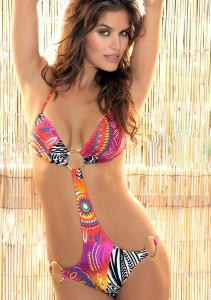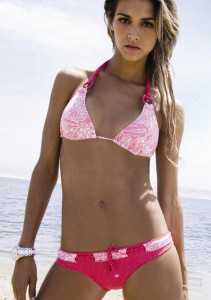 Swimsuit Sizing can often seem like one of life’s cruel little jokes. Manufacturers appear to have an inordinate amount of difficulty in deciding on the universal prototype of a size 6 (or any size for that matter). Thus, the size that may have fit and worked wonderfully in last year’s swimsuit may be causing you great disappointment in the next season’s swimsuit search. In addition, manufacturers are unwilling to come to agreement over whether swimsuits should be sized as dresses (0-16) or as shirts (S-XL). The result is a general hodgepodge of swimsuit sizing that plays havoc with swimsuit consumers’ time and emotional stability. In general, to get a good swimsuit fit, you should look for a swimsuit approximately one or two sizes larger than your dress size. When trying the suit on, be sure to lift your arms, bend, and sit down to ensure everything stays covered. Below are some general tips to finding a good swimsuit fit in all areas of the body:
Swimsuit Sizing can often seem like one of life’s cruel little jokes. Manufacturers appear to have an inordinate amount of difficulty in deciding on the universal prototype of a size 6 (or any size for that matter). Thus, the size that may have fit and worked wonderfully in last year’s swimsuit may be causing you great disappointment in the next season’s swimsuit search. In addition, manufacturers are unwilling to come to agreement over whether swimsuits should be sized as dresses (0-16) or as shirts (S-XL). The result is a general hodgepodge of swimsuit sizing that plays havoc with swimsuit consumers’ time and emotional stability. In general, to get a good swimsuit fit, you should look for a swimsuit approximately one or two sizes larger than your dress size. When trying the suit on, be sure to lift your arms, bend, and sit down to ensure everything stays covered. Below are some general tips to finding a good swimsuit fit in all areas of the body:
 Torso: If you are going with a classic bikini style (bare midriff and back), the body section of a swimsuit is not really applicable. However, if you think you may be interested in a Tankini or One Piece , make sure the torso portion of your swimsuit lies perfectly flat on the body. You will want a good, streamlined fit with the right percentage of Lycra content. Still, be wary of too tight tankini tops; they will tend to cause belly bulges in even the slimmest of women.
Torso: If you are going with a classic bikini style (bare midriff and back), the body section of a swimsuit is not really applicable. However, if you think you may be interested in a Tankini or One Piece , make sure the torso portion of your swimsuit lies perfectly flat on the body. You will want a good, streamlined fit with the right percentage of Lycra content. Still, be wary of too tight tankini tops; they will tend to cause belly bulges in even the slimmest of women.
 Leg Openings and Waistbands: Make sure that the leg openings and the waistband of your bikini bottoms are not puckering or digging into your skin. Puckering will result in an uncomfortable and unflattering fit. If the bottoms are digging in anywhere, you will want to try a larger size or different style. If the bottoms are not offering enough coverage, a different style is the answer such as Moderate cut, Brazilian cut, or Ruched, not a different size. For most people, the most flattering leg opening falls an inch below the top of the hipbone. To get a good fit, start with this style of leg opening and experiment from there. Also, remember to check your butt in the mirror to be sure the bottoms are offering enough coverage.
Leg Openings and Waistbands: Make sure that the leg openings and the waistband of your bikini bottoms are not puckering or digging into your skin. Puckering will result in an uncomfortable and unflattering fit. If the bottoms are digging in anywhere, you will want to try a larger size or different style. If the bottoms are not offering enough coverage, a different style is the answer such as Moderate cut, Brazilian cut, or Ruched, not a different size. For most people, the most flattering leg opening falls an inch below the top of the hipbone. To get a good fit, start with this style of leg opening and experiment from there. Also, remember to check your butt in the mirror to be sure the bottoms are offering enough coverage.
Straps: Bikini straps should lie comfortably on your shoulders without digging in or falling down. If the straps are digging in, you will probably want to choose a larger top size. Conversely, if the straps are falling down, you may want to try a smaller size or different style. If you are trying on a style with tie straps, move around a bit in the dressing room to make sure the straps stay tied.
 Bust: When trying on a bikini top, lift your arms to make sure the top offers enough coverage and does not creep up on you. Make sure that you can adjust the straps so you will feel comfortable and secure in your bikini top. If you are looking at a bikini with a built-in underwire, follow the same rules as when shopping for a bra. The underwire should completely cover the bottom half of the breast and not be sitting on any breast tissue. Your breasts should fill the cups of your bikini top completely without spilling over. For the best top sizing, look for manufacturers that offer bra sizing. If you cannot find such a manufacturer with a swimsuit style you like, look for a top with adjustable or tie straps at the back and neck. For a list of designer swimwear manufacturers offering D-Cup sizing, Click Here!
Bust: When trying on a bikini top, lift your arms to make sure the top offers enough coverage and does not creep up on you. Make sure that you can adjust the straps so you will feel comfortable and secure in your bikini top. If you are looking at a bikini with a built-in underwire, follow the same rules as when shopping for a bra. The underwire should completely cover the bottom half of the breast and not be sitting on any breast tissue. Your breasts should fill the cups of your bikini top completely without spilling over. For the best top sizing, look for manufacturers that offer bra sizing. If you cannot find such a manufacturer with a swimsuit style you like, look for a top with adjustable or tie straps at the back and neck. For a list of designer swimwear manufacturers offering D-Cup sizing, Click Here!



1 Comment
katie pie · July 22, 2010 at 4:40 pm
I wish I could write like you as Margaret Laurence once said “When I say “work” I only mean writing. Everything else is just odd jobs.”
Comments are closed.